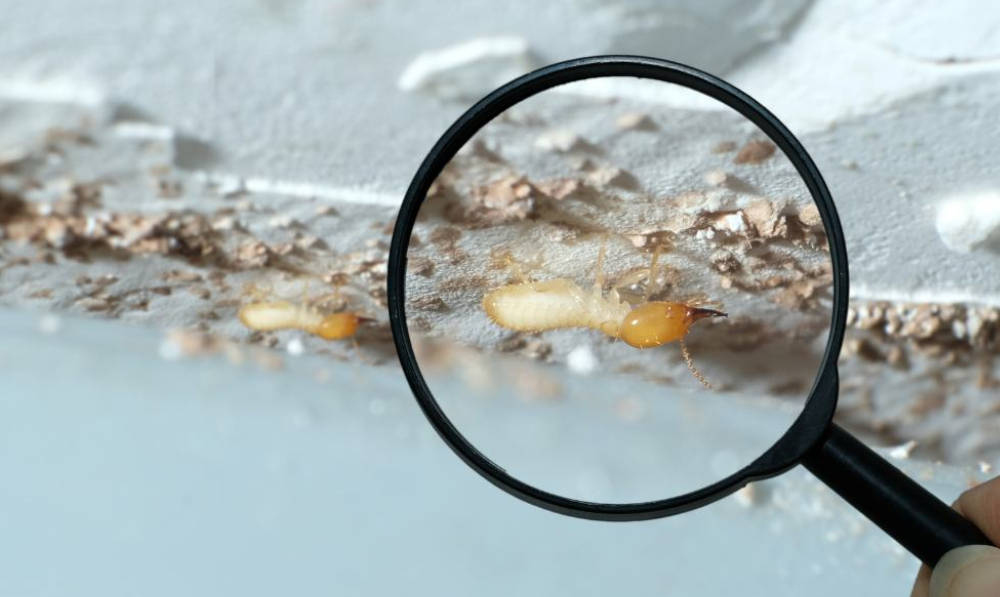KEY TAKEAWAYS:
Mud Tubes: Look for pencil-sized mud tubes along the foundation, walls, or other surfaces, indicating active termite activity.
Discarded Wings: Keep an eye out for piles of discarded wings near windows, doors, or entry points, especially during swarming seasons.
Hollow-Sounding Wood: Tap or knock on wooden surfaces – if they sound hollow, it’s a possible sign of termite damage.
Frass: Watch for small piles of sawdust-like material (frass) near termite nests or infested areas as a sign of termite presence.
Sagging Floors or Ceilings: Be alert for unexplained changes in the levelness of floors or ceilings, which could indicate structural damage from termites.
Termites can wreak havoc on homes and buildings without being noticed until significant damage has already been done.
Identifying the early signs of a termite infestation is crucial for early intervention and minimizing damage.
Here’s a guide to help you recognize these signs before they become a serious problem.
Mud Tubes
One of the most common signs of a termite infestation is the presence of mud tubes. These pencil-sized tunnels are typically found near the foundation of a building, along walls, or on other surfaces.
Termites use these tubes as protective pathways between their nest and a food source. If you notice mud tubes on your property, it’s a clear indication that termites are present and active.
Discarded Wings
During certain times of the year, reproductive termites, known as swarmers, leave their nests to establish new colonies. After swarming, they shed their wings, leaving behind piles of discarded wings near windowsills, doors, and other entry points.
Finding these discarded wings is a strong indicator of a nearby termite infestation.
Hollow-Sounding Wood
Termites feed on wood from the inside out, leaving a thin veneer of wood or paint on the surface. If you tap or knock on a wooden surface and it sounds hollow, it could be a sign of termite damage.
Inspect any areas of your home that sound hollow, paying close attention to wooden beams, door frames, and window sills.
Frass
Termite excrement, also known as frass, resembles sawdust or coffee grounds and is often found near termite nests or areas of infestation.
If you notice small piles of what looks like sawdust around your home, particularly near wooden structures, it may be an indication of a termite presence.
Sagging Floors or Ceilings
As termites consume wood within the structure of a building, it can weaken the structural integrity, leading to sagging or drooping floors and ceilings.
If you notice any unexplained changes in the levelness of your floors or ceilings, it’s essential to investigate further for potential termite damage.
Tight-Fitting Doors or Windows
Swollen or tight-fitting doors and windows could be a sign of excess moisture, which is attractive to termites. As these pests burrow into wooden structures, they introduce moisture, causing the wood to swell and making it difficult to open and close doors and windows smoothly.
Presence of Termite Swarmers
Termite swarmers are winged termites that emerge from mature colonies to establish new ones. If you observe swarms of flying insects, particularly around light sources, it’s a clear sign that a termite colony is nearby.
Catching these swarmers early can help prevent a full-blown infestation.
Conclusion
Early detection of termite infestations is key to minimizing damage and the associated costs of repair. Regular inspections of your home, both indoors and outdoors, can help you identify the early signs of a termite problem.
If you suspect a termite infestation, it’s essential to contact a licensed pest control professional promptly to assess the situation and implement appropriate treatment measures.
By staying vigilant and proactive, you can protect your home from the destructive effects of termites.

